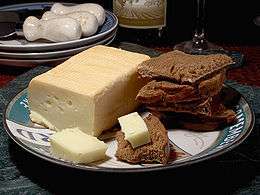Limburger
| Limburger | |
|---|---|
 | |
| Country of origin | Belgium, Germany, & Netherlands |
| Region, town | Limburg |
| Source of milk | Cow |
| Pasteurized | Yes |
| Texture | Semi-soft |
| Aging time | 2-3 months |
|
| |
Limburger is a cheese that originated during the 19th century in the historical Duchy of Limburg, which is now divided between Belgium, Germany, and Netherlands. The cheese is especially known for its strong smell caused by the bacterium Brevibacterium linens.[1]
Manufacture
While today most Limburger is produced in Germany, Herve cheese is a type of Limburger which is still produced in the territory of the old Duchy of Limburg, in Belgium. Herve is located near Liège, and the borders separating Belgium from the Netherlands and Germany. The "Pays de Herve" is a hilly area between the Vesdre and Meuse rivers.
In the US, it was first produced in 1867 by Rudolph Benkerts in his cellar from pasteurized goat's milk.[2] A few years later, 25 factories produced this cheese. The Chalet Cheese Cooperative in Monroe, Wisconsin is the only American company that makes this cheese. It is also manufactured in Canada, where it is a German-Canadian cultural marker, by the Oak Grove Cheese Company in New Hamburg, Ontario.
Description
In its first month, the cheese is firmer and more crumbly, similar to the texture of feta cheese. After about six weeks, the cheese becomes softer along the edges but is still firm on the inside and can be described as salty and chalky. After two months of its life, it is mostly creamy and much smoother. Once it reaches three months, the cheese produces its notorious smell because of the bacterium used to ferment Limburger cheese and many other smear-ripened cheeses.[3] This is Brevibacterium linens, the same one found on human skin that is partially responsible for body odor and particularly foot odor.[1]
Uses
One of the most traditional ways of eating limburger is the limburger sandwich. After three months, when the cheese has ripened, it becomes spreadable. The cheese is often spread thick (more than 0.5 cm or 0.2 inch) on firm-textured 100% rye bread, with a large, thick slice of onion, and is typically served with strong black coffee or lager beer. Alternatively, for heartier eaters, chunks or slices of the cheese up to 1.5 cm (0.6 inch) thick can be cut off the block and placed in the sandwich. This sandwich still remains very popular among the descendants of German immigrants in the Midwestern United States, such as Cincinnati, and German Village in Columbus, Ohio. However, it is markedly less popular among the descendants born after about 1960, mainly because of the permeating smell, and the inconvenience of going to specialty cheese and sausage shops to obtain it. In Wisconsin, the Limburger sandwich can be found on menus at certain restaurants, accompanied by brown mustard.[4]
Limburger and its characteristic odor are a frequent butt of jokes. Reactions to, and misinterpretations of, the smell of Limburger cheese were gags used in numerous Little Rascals and Three Stooges comedy shorts. Also, the arch-enemy of the Biker Mice from Mars has the name Lawrence Limburger, complete with terrible body odor.
In 2006, a study showing that the malaria mosquito (Anopheles gambiae) is attracted equally to the smell of Limburger and to the smell of human feet earned the Ig Nobel Prize in the area of biology.[5][6] The results of the study were published in the medical journal The Lancet on 9 November 1996.
Nutrition facts
100 g of Limburger contains:
- 17 g of saturated fat and 27 g of total fat.
- 327 calories, of which 240 calories are from fat.
- 90 mg of cholesterol
- 800 mg of sodium
- 20 g of protein[7]
See also
References
- Notes
- 1 2 Crump, Marty (2009). Sexy Orchids Make Lousy Lovers: & Other Unusual Relationships. University of Chicago Press. p. 160. ISBN 9780226121871.
- ↑ "Limburger Cheese, History of Limburger Cheese, Limburger Cheese Sandwich Recipem How To Make A Limburger Sandwich". Whatscookingamerica.net. Retrieved 14 November 2013.
- ↑ Fox, Patrick. Cheese: Chemistry, Physics and Microbiology. p. 200.
- ↑ "page does not exist". April 2006. Retrieved 7 May 2009.
- ↑ "Ig Nobel Prize list of past winners". Improbable.com. Retrieved 14 November 2013.
- ↑ Knols BG (November 1996). "On human odour, malaria mosquitoes, and Limburger". Lancet. 348 (9037): 1322. doi:10.1016/S0140-6736(05)65812-6. PMID 8909415.
- ↑ "Nutrition Facts and Information for Cheese, limburger". Nutritiondata.self.com. Retrieved 23 November 2016.
External links
-
 Media related to Limburger cheese at Wikimedia Commons
Media related to Limburger cheese at Wikimedia Commons - TED-talk about "Cheese, dogs and a pill to kill mosquitoes and end malaria" at TEDxMaastricht,·Apr 2012